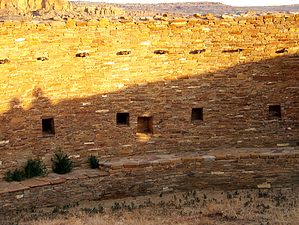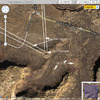| Guide | ♦ | 9 Triplogs | 2 Topics |
details | drive | permit | forecast | map |
stats |
photos | triplogs | topics | location |
| 24 | 9 | 2 |
The sun will come up tomorrow... by PaleoRob The trail begins at the signed pull-out along the Chaco loop road, just past the Chaco Wash bridge. There is a pit toilet but no water - make sure your water bottles are filled back at the visitor's center. Also be sure to get a trail guide from the kiosk at the parking area; it will help explain some of the sights in detail. It costs 50 cents, or free if you return it after your hike.
The structure is the Great Kiva of Casa Rinconada. Aligned almost perfectly with the four cardinal directions, it sits directly due south of Pueblo Bonito's dividing wall, through an alignment with its central wall, the gap in the trash mounds in front of Bonito, and Casa Rinconada's northern antechamber. During the summer solstice a beam of light will enter the window to the east of the northern antechamber, and as the sun rises that beam of light will come to rest in a low niche on the western side of the kiva wall; both the window and the niche have been reconstructed in the past, so it is not known how accurate this solar alignment is, but it is striking regardless. The floorplan of the Great Kiva is fairly standard, with one exception; a tunnel that leads from the northern antechamber to the center of the kiva floor. This may have allowed priests or dancers to appear unseen in the center of the kiva during ceremonies. The tunnel was likely covered with wood and plaster with a reed and wood hatchway at its end. Casa Rinconada certainly exemplifies the great feats of architecture that the Chacoans could, and routinely did, go to. The next stops along the trail showcase the fact that just because they could build impressive public architecture, they didn't do so all the time. The next several ruins are some of the BC# small sites. Called Hosta Butte Phase after the prominent butte of the same name to the south of Chaco, where this type was first recognized. These small sites are far more typical of Anasazi dwellings across the Colorado Plateau, with several storage rooms, a couple living rooms, and a kiva or two all within one complex. Usually these consisted of just a single story, though two stories in places were not unusual. These Hosta Butte sites are generally clustered around Great Houses, and likely acted as the support mechanism that allowed the Great Houses to keep doing whatever it was that there were doing. The trail book guides your through some of the pertinent features of several of these sites. The loop then brings you back to your car. This is the last hike available on the Chaco Loop Road before returning to the Visitor's Center, but don't miss out on the prehistoric staircase just a couple dozen yards down the road. You can't hike to it or climb it, but be sure to stop and look at it just the same. It is a real neat example of Chacoan road engineering. Check out the Triplogs. Leave No Trace and +Add a Triplog after your hike to support this local community. | ||||||||||||||||||||||||||||||||||||||||||||||||||||||||||||||||||||||||||||||||||||
 Route Editor
Route Editor





